Ornamental and Lawn Pest Control (For Homeowners)
- Jump To:
- Pests Of Trees, Shrubs, And Flowers
- Aphids
- Bagworms
- Borers
- Ash/Lilac Borer
- Iris Borer
- Bark Beetles (in pines)
- Elm Bark Beetles
- Boxelder Bugs and Red-Shouldered Bugs
- Caterpillars
- Elm Leaf Beetle, Willow Leaf Beetle, and Elm Calligrapha Beetle
- Flea Beetles
- Galls
- Grasshoppers
- June (May) Beetles and Japanese Beetles
- Lace Bugs
- Treehoppers
- Leafminers
- Millipedes
- Mites
- Pine Tip Moth (larvae)
- Puss Caterpillar/ Io Moth and Othere “Stinging Caterpillars"
- Scales and Mealybugs
- Thrips
- Ants
- Armyworms and Cutworms
- Billbugs
- Chiggers and Ticks
- Chinch Bugs
- Digger Wasp
- Fleas
- Grasshoppers(2)
- Leafhoppers
- Millipedes(2)
- Sod Webworms
- White Grubs
This fact sheet describes some common arthropod pest problems encountered on various ornamentals and turfgrass lawns in Oklahoma. If arthropod pest problems arise that are not covered here, consult your OSU County Extension Office for assistance.
Many arthropod pest problems are solved through natural control factors such as weather, disease, parasites, and predators. When nature either does not solve the pest problem or is slow to act, other controls may be warranted. Chemical pesticides often provide the quickest and most dependable control, and in many instances, there may be no other alternatives.
Pesticides are chemicals of plant, animal, or synthetic origin manufactured to kill pests – insects, weeds, plant disease organisms, and rodents. Materials poisonous to one organism are usually poisonous to other organisms if the dosage is large enough. Pesticides can be applied safely when a few basic rules are followed and common sense is used. Refer to OSU Extension Fact Sheets EPP-7450, EPP-7453 and EPP-7457 for more information on pesticide safety. For information on insect control in the vegetable garden, refer to OSU Extension Fact Sheet EPP-7313.
Note: Whenever possible, buy and grow pest resistant plants such as Oklahoma Proven selections (http://oklahomaproven.okstate.edu) or other recommended varieties. By doing so, the need for pest control measures can be greatly reduced.
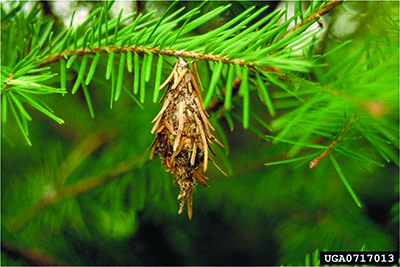
Bagworm. Photo courtesy Eric R. Day, Virginia Polytechnic Institute and State University, Bugwood.org
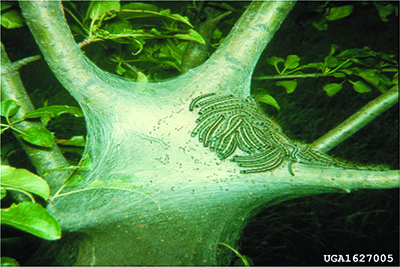
Eastern Tent Caterpillar. Photo courtesy John A. Weidhass, Virginia Polytechnic Institute and State University,
Bugwood.org
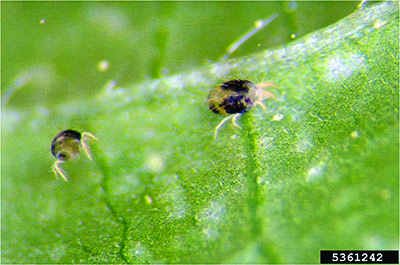
Two-spotted Spider Mite. Photo courtesy Frank Peairs, Colorado State University, Bugwood.org
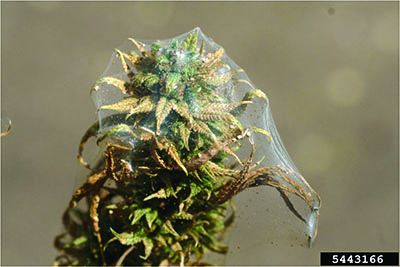
Two-spotted Spider Mite Webbing. Photo courtesy Whitney Cranshaw, Colorado State University, Bugwood.org
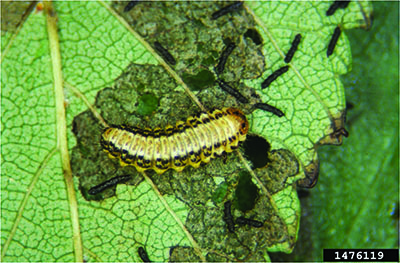
Elm Leaf Beetle (larvae). Photo courtesy Whitney Cranshaw, Colorado State University, Bugwood.org
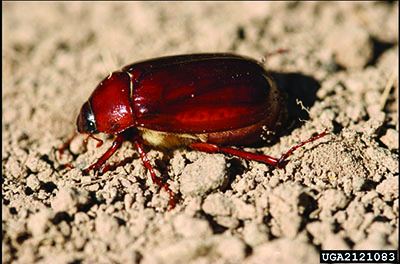
May-June Beetle. Photo courtesy Steven Katovich, USDA Forest Service, Bugwood.org
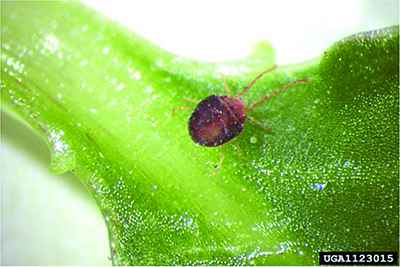
Clover Mite. Photo courtesy Rayanne Lehman, Pennsylvania Department of Agriculture, Bugwood.org
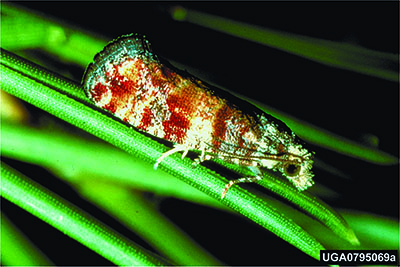
Pine Tip Moth (adult). Photo courtesy James A. Richmond, USDA Forest Service, Bugwood.org
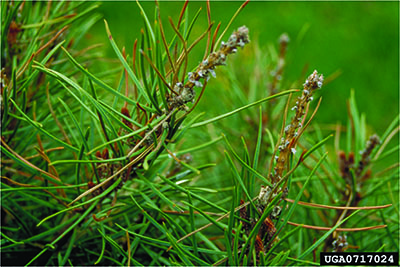
Pine Tip Moth Damage. Photo courtesy Eric R. Day, Virginia Polytechnic Institute and State University,
Bugwood.org
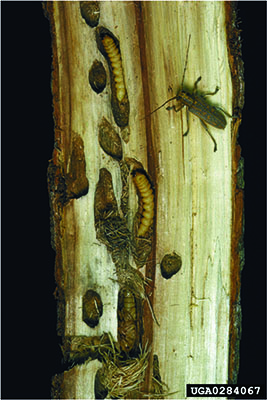
Poplar Borer. Photo courtesy James Solomon, USDA Forest Service, Bugwood.org
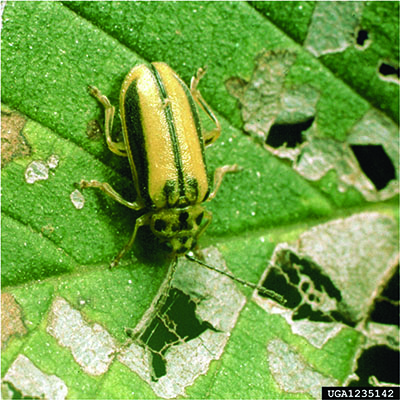
Elm Leaf Beetle. Photo courtesy Clemson University – USDA Cooperative Extension Slide Series, Bugwood.org
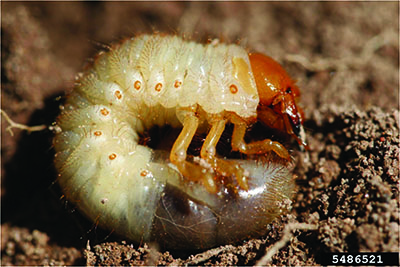
May-June Beetle Larva. Photo courtesy Steven Katovich, USDA Forest Service, Bugwood.org
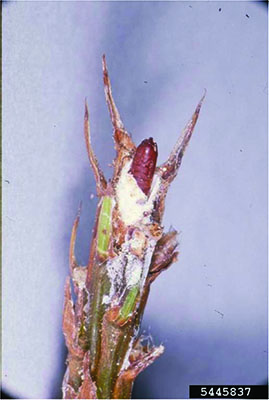
Pine Tip Moth (larvae). Photo courtesy Darrell Ross, Oregon State University, Bugwood.org
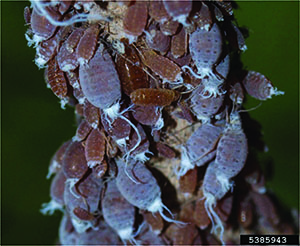
Wooly Maple Aphids. Photo courtesy Eric Rebek, Oklahoma State University, Bugwood.org
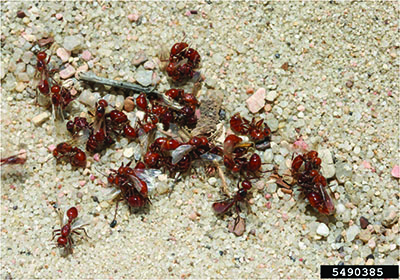
Harvester Ants. Photo courtesy Whitney Cranshaw, Colorado State University, Bugwood.org

Spring Cankerworm. Photo courtesy James B. Hanson, USDA Forest Service, Bugwood.org
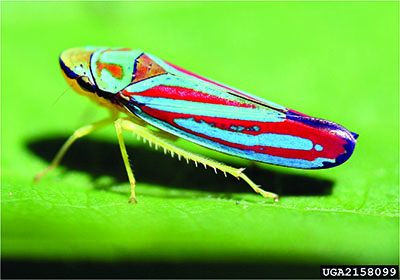
Candystriped Leafhopper. Photo courtesy David Cappaert, Michigan State University, Bugwood.org

Euonymus Scale. Photo courtesy Clemson University – USDA Cooperative Extension Slide Series, Bugwood.org

Fall Armyworm. Photo courtesy Clemson University – USDA Cooperative Extension Slide Series, Bugwood.org
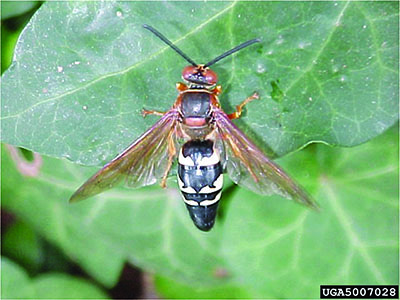
Cicada Killer Wasp. Photo courtesy Nancy Hinkle, University of Georgia, Bugwood.org
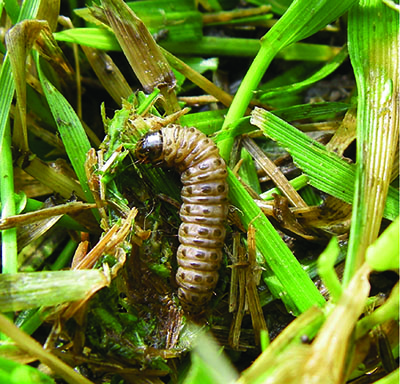
Sod Webworm. Photo courtesy Purdue University, Department of Entomology
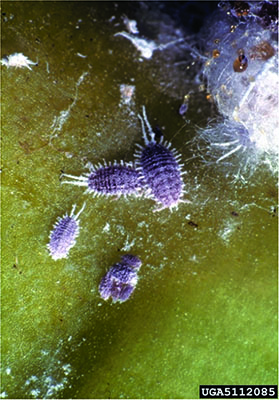
Mealybugs. Photo courtesy United States National Collection of Scale Insects Photographs Archive,
USDA Agricultural Research Service, Bugwood.org
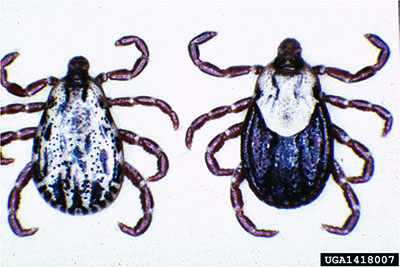
American Dog Ticks. Photo courtesy Mat Pound, USDA Agricultural Research Service, Bugwood.org
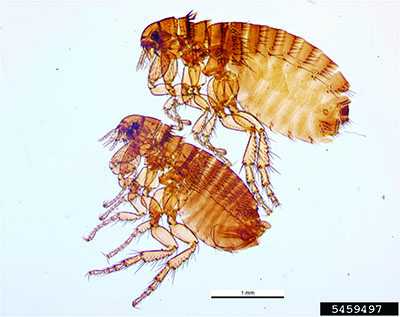
Flea. Photo courtesy Pest and Diseases Image Library, Bugwood.org
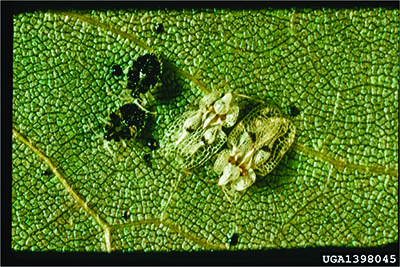
Sycamore Lace Bugs. Photo courtesy USDA Forest Service – Northeastern Area Archive, USDA Forest Service,
Bugwood.org
Pests Of Trees, Shrubs, And Flowers
Aphids
(Pest, Time Most Prevalent, & Other Information)
- Measure 1/8 to 1/5 inch long.
- Pear-shaped, soft-bodied, sucking insects. Active all growing season.
- Aphids secrete honeydew (sticky, sugar-like material), which may attract ants and flies, and provide growing media for sooty mold.
- Aphids generally attack the tender terminals and leaves. Leaves may twist and curl and become distorted.
- Small infestations can often be washed off plants with strong water pressure.
| Pesticide Common Name | Pesticide Trade Name | Pesticide Class | Comments |
|---|---|---|---|
| Acetamiprid | Ortho Max Flower, Fruit and Vegetable Insect Killer RTU |
4A | Systemic insecticide. Apply as a foliar spray. |
| Carbaryl | GardenTech Sevin Concentrate Bug Killer | 1A | See note at end of section on Sevin. |
| Dinotefuran | Green Light Tree and Shrub InsectControl w/ Safari 2G or Gordon’s Professional Turf & Ornamental Products Zylam Liquid Systemic Insecticide |
4A | Systemic insecticide. Apply to soil around base of trunk. Determine rate based on trunk diameter or height of shrub. BEE CAUTION: Do not apply to plants in bloom. |
| Insecticidal Soap | Garden Safe Brand Insecticidal Soap Insect Killer | NS | Carefully read label of insecticidal soap products for phytotoxicity statements. |
| Imidacloprid | Bayer Advanced 12 Month Tree & Shrub Insect Control or Ferti-Lome Tree & Shrub Systemic Insect Drench |
4A | Use imidacloprid as a soil drench around base of trunk. Determine rate based on trunk diameter or height of shrub. BEE CAUTION: Do not apply to plants in bloom. |
| Imidacloprid + Clothianidin | Bayer Advanced Tree & Shrub Protect and Feed RTU Granules II |
4A + 4A | Apply granules around base of trunk and water in to soil. Determine rate based on trunk diameter or height of shrub. BEE CAUTION: Do not apply to plants in bloom. |
| Malathion | Gordon’s Malathion 50% Spray or Hi-Yield 55% Malathion Spray |
1B | Carefully read label of malathion products for phytotoxicity statements. |
| Mineral Oil | Bonide All Seasons Horticultural & Dormant Spray Oil Concentrate |
HO | Do not apply dormant oil concentrations to actively growing plants nor to broadleaf evergreens, maple, mountain ash, or beech. |
| Neem Oil | Garden Safe Brand Neem Oil Extract Concentrate or Bonide Neem Oil Fungicide/Miticide/ Insecticide RTU |
UN | Carefully read label of neem oil products for phytoxicity statements. |
Bagworms
(Pest, Time Most Prevalent, & Other Information)
- Measure 1-2 inches long (bagworm case).
- Active May through September.
- Common caterpillar pests on cedars, arborvitae, and sometimes feed on bald cypress, elms, pines, willows, maples, sycamores, and other trees.
- Small infestations can be removed by hand in winter before larvae emerge in May, but be sure to destroy all bags.
| Pesticide Common Name | Pesticide Trade Name | Pesticide Class | Comments |
|---|---|---|---|
| Bacillus thuringiensis (B.t.) subsp. kurstaki |
Thuricide or Dipel | 11A | Apply B.t. early while caterpillars are still small (e.g., late May or early June).
Less effective for large larvae. |
| Carbaryl | GardenTech Sevin Concentrate Bug Killer | 1A | See note at end of section on Sevin. |
| Malathion | Gordon’s Malathion 50% Spray or Hi-Yield 55% Malathion Spray |
1B | Carefully read label of malathion products for phytotoxicity statements. |
| Spinosad | Ferti-Lome Borer, Bagworm, Tent Caterpillar & Leafminer Spray | 5 | Apply spinosad early while caterpillars are still small (e.g., late May or early June). Less effective for large larvae. |
Borers
(Pest, Time Most Prevalent, & Other Information)
- FLATHEADED BORERS, ROUNDHEADED BORERS, SHOTHOLE BORERS
- Measure 1/2 to 1 3/4 inches long.
- Active spring through fall.
- See OSU Fact Sheet EPP-7326 for additional information about woodborers.
| Pesticide Common Name | Pesticide Trade Name | Pesticide Class | Comments |
|---|---|---|---|
| Dinotefuran | Green Light Tree and Shrub Insect Control w/ Safari 2G or Gordon’s Professional Turf & Ornamental Products Zylam Liquid Systemic Insecticide | 4A | Systemic insecticide. pply to soil around base of trunk. Determine rate based on trunk diameter or height of shrub. BEE CAUTION: Do not apply to plants in bloom. |
| Imidacloprid | Bayer Advanced 12 Month Tree & Shrub Insect Control or Ferti-Lome Tree & Shrub Systemic Insect Drench | 4A | Use imidacloprid as a soil drench around base of trunk. Determine rate based on trunk diameter or height of shrub. BEE CAUTION: Do not apply to plants in bloom. |
| Imidacloprid + Clothianidin | Bayer Advanced Tree & Shrub Protect and Feed RTU Granules II | 4A + 4A | Apply granules around base of trunk and water in to soil. Determine rate based on trunk diameter or height of shrub. BEE CAUTION: Do not apply to plants in bloom. |
Ash/Lilac Borer
(Pest, Time Most Prevalent, & Other Information)
- Measure up to 1 inch long. Adult moths are wasp mimics.
- Active spring through fall.
- As a preventative measure, it is helpful to insure health of trees with proper watering and fertilizer.
| Pesticide Common Name | Pesticide Trade Name | Pesticide Class | Comments |
|---|---|---|---|
| Permethrin | Hi-Yield Indoor/Outdoor Broad Use Insecticide | 3A | Spray trunk when adult moths are active to target egg-laying adults and newly emerging larvae. Monitor adult activity with pheromone traps.et |
Iris Borer
(Pest, Time Most Prevalent, & Other Information)
- Larvae are pink caterpillars measuring up to 2 inches long.
- Active late April through August.
- Larvae tunnel within leaves, stems, and rhizomes (roots).
| Pesticide Common Name | Pesticide Trade Name | Pesticide Class | Comments |
|---|---|---|---|
| Steinernema carpocapsae | Ecomask | BLO | Beneficial nematodes are tiny roundworms that attack a variety of insect pests. Levels of control vary, but nematodes function best at soil temperatures between 60° and 93°F. |
| Piperonyl Butoxide + Pyrethrins | GardenTech Worry Free Brand Concentrate |
NS + 3A | |
| Spinosad | Ferti-Lome Borer, Bagworm, Tent Caterpillar & Leafminer Spray | 5A | Apply spray to upper and lower leaf surfaces when eggs hatch, corresponding to new growth measuring 4 to 6 inches. A second spray may be needed 10 to 14 days later. |
Bark Beetles (in pines)
(Pest, Time Most Prevalent, & Other Information)
- Adults measure 1/20 to 1/5 inch long
- Small, cylindrical, brown to black beetles that tunnel and create feeding galleries below bark surface.
- Active spring through fall.
| Pesticide Common Name | Pesticide Trade Name |
Pesticide Class | Comments |
|---|---|---|---|
| Imidacloprid | Bayer Advanced 12 Month Tree & Shrub Insect Control or Ferti-Lome Tree & Shrub Systemic Insect Drench |
4A | Use imidacloprid as a soil drench around base of trunk. Determine rate based on trunk diameter or height of shrub. BEE CAUTION: Do not apply to plants in bloom. |
| Imidacloprid + Clothianidin | Bayer Advanced Tree & Shrub Protect and Feed RTU Granules II |
4A + 4A | Apply granules around base of trunk and water in to soil. Determine rate based on trunk diameter or height of shrub. BEE CAUTION: Do not apply to plants in bloom. |
| Piperonyl Butoxide + Pyrethrins | GardenTech Worry Free BrandConcentrate | NS + 3A |
Elm Bark Beetles
(Pest, Time Most Prevalent, & Other Information)
- See EPP-7602: Dutch Elm Disease for information about elm bark beetle vectors.
| Comments |
|---|
| Only restricted use pesticides are currently available for effective control of elm bark beetle and the disease it transmits, Dutch Elm Disease. Consult a certified arborist or other tree care professional for control options. |
Boxelder Bugs and Red-Shouldered Bugs
(Pest, Time Most Prevalent, & Other Information)
- Measure 1/2 to 1 3/4 inches long.
- Nuisance household pest in the fall. Feed on seeds of boxelder, golden raintree, and soapberry, but don’t injure trees. Avoid planting host trees in close proximity to house.
- Plug openings around windows and doors, and caulk small openings that can serve as points of entry.
- Target young nymphs in early summer for best control.
| Pesticide Common Name | Pesticide Trade Name |
Pesticide Class | Comments |
|---|---|---|---|
| Carbaryl | GardenTech Sevin Concentrate Bug Killer | 1A | See note at end of section on Sevin. |
| Cyfluthrin | Bayer Advanced Power Force Multi-Insect Killer Concentrate | 3A | |
| Malathion | Gordon’s Malathion 50% Spray or Hi-Yield 55% Malathion Spray | 1B | Carefully read label of malathion products for phytotoxicity statements. |
| Piperonyl Butoxide + Pyrethrins |
GardenTech Worry Free Brand Concentrate |
NS + 3A |
Caterpillars
(Pest, Time Most Prevalent, & Other Information)
- Includes cankerworms, cutworms, webworms, tent caterpillars, and leafrollers/leaftiers.
- Measure 1/2 to 2 inches long.
- Active spring through fall. Larvae feed on foliage. Some species roll and tie leaves with silk and some build webs or tents around foliage or in crotches of limbs.
- Check label for specific caterpillar pests controlled by each product and use accordingly.
| Pesticide Common Name | Pesticide Trade Name | Pesticide Class | Comments |
|---|---|---|---|
| Acetamiprid | Ortho Max Flower, Fruit and Vegetable Insect Killer RTU | 4A | Systemic insecticide. Apply as a foliar spray. |
| Bacillus thuringiensis (B.t.) subsp. kurstaki | Bonide Thuricide Bt or Ferti-Lome Dipel Dust |
11A | Apply B.t. early while caterpillars are still small. Less effective for large larvae. B.t. stops larvae from feeding, but has a delayed killing action. B.t. does NOT control sawflies. |
| Carbaryl | GardenTech Sevin Concentrate Bug Killer | 1A | See note at end of section on Sevin. |
| Cyfluthrin | Bayer Advanced Power Force Multi-Insect Killer Concentrate | 3A | |
| Esfenvalerate | Ortho Bug-B-Gon Max Garden & Landscape Insect Killer |
3A | |
| Insecticidal Soap | Garden Safe Brand Insecticidal Soap Insect Killer | NS | Carefully read label of insecticidal soap products for phytotoxicity statements. |
| Lambda Cyhalothrin | Bonide Caterpillar Killer | 3A | |
| Malathion | Gordon’s Malathion 50% Spray or Hi-Yield 55% Malathion Spray | 1B | Carefully read label of malathion products for phytotoxicity statements. |
| Mineral Oil | Bonide All Seasons Horticultural & Dormant Spray Oil Concentrate | HO | Do not apply dormant oil concentrations to actively growing plants nor to broadleaf evergreens, maple, mountain ash, or beech. |
| Neem Oil | Garden Safe Brand Neem Oil Extract Concentrate or Bonide Neem Oil Fungicide/Miticide/ Insecticide RTU |
UN | Labeled for leafrollers only. Carefully read label of neem oil products for phytoxicity statements. |
| Spinosad | Ferti-Lome Borer, Bagworm, Tent Caterpillar, & Leafminer Spray | 5 | Apply spinosad early while caterpillars are still small. Less effective for large larvae. |
Elm Leaf Beetle, Willow Leaf Beetle, and Elm Calligrapha Beetle
(Pest, Time Most Prevalent, & Other Information)
- Adults measure 1/8 to 1/4 inch long. Larvae measure 1/4 to 3/8 inch long.
- These leaf-feeding beetles are active late spring to late summer. Both adults and larvae feed on foliage, but larvae cause the most damage by skeletonizing the leaves.
| Pesticide Common Name | Pesticide Trade Name | Pesticide Class | Comments |
|---|---|---|---|
| Carbaryl | GardenTech Sevin Concentrate Bug Killer | 1A | See note at end of section on Sevin. |
| Cyfluthrin | Bayer Advanced Power Force Multi-Insect Killer Concentrate | 3A | |
| Dinotefuran | Green Light Tree and Shrub Insect Control w/Safari 2G or Gordon’s Professional Turf & Ornamental Products Zylam Liquid Systemic Insecticide | 4A | Systemic insecticide. Apply to soil around base of trunk. Determine rate based on trunk diameter or height of shrub. BEE CAUTION: Do not apply to plants in bloom. |
| Imidacloprid | Bayer Advanced 12 Month Tree & Shrub Insect Control or Ferti-Lome Tree & Shrub Systemic Insect Drench |
4A | Use imidacloprid as a soil drench around base of trunk. Determine rate based on trunk diameter or height of shrub. BEE CAUTION: Do not apply to plants in bloom. |
| Imidacloprid + Clothianidin | Bayer Advanced Tree & Shrub Protect and Feed RTU Granules II |
4A + 4A | Apply granules around base of trunk and water in to soil. Determine rate based on trunk diameter or height of shrub. BEE CAUTION: Do not apply to plants in bloom. |
| Mineral Oil | Bonide All Seasons Horticultural & Dormant Spray Oil Concentrate | HO | Effective against larvae. Do not apply dormant oil concentrations to actively growing plants nor to broadleaf evergreens, maple, mountain ash, or beech. |
| Spinosad | Ferti-Lome Borer, Bagworm, Tent Caterpillar, & Leafminer Spray | 5 | Apply when larvae are small and actively feeding. |
Flea Beetles
(Pest, Time Most Prevalent, & Other Information)
- Measure 1/16 to 1/8 inch long.
- Tiny, black beetles with enlarged hind legs designed for jumping.
- Active in summer, feeding on foliage of a wide variety of landscape plants.
| Pesticide Common Name | Pesticide Trade Name | Pesticide Class | Comments |
|---|---|---|---|
| Acetamiprid | Ortho Max Flower, Fruit and Vegetable Insect Killer RTU | 4A | Systemic insecticide. Apply as a foliar spray. |
| Carbaryl | GardenTech Sevin Concentrate Bug Killer | 1A | See note at end of section on Sevin. |
| Cyfluthrin | Bayer Advanced Power Force Multi-Insect Killer Concentrate | 3A | |
| Lambda Cyhalothrin | Bonide Caterpillar Killer | 3A |
Galls
(Pest, Time Most Prevalent, & Other Information)
- New growth forms during growing season.
- See OSU Fact Sheet EPP-7168 for detailed information about plant galls.
- Gall problems can be reduced by applying the chemicals listed in early spring (bud swell), then again at bud break, and again when leaves are half grown.
| Pesticide Common Name | Pesticide Trade Name | Pesticide Class | Comments |
|---|---|---|---|
| Carbaryl | GardenTech Sevin Concentrate Bug Killer | 1A | Labeled for gall-making wasps and midges only. See note at end of section on Sevin. |
| Mineral Oil | Bonide All Seasons Horticultural & Dormant Spray Oil Concentrate | HO | Do not apply dormant oil concentrations to actively growing plants nor to broadleaf evergreens, maple, mountain ash, or beech. |
Grasshoppers
(Pest, Time Most Prevalent, & Other Information)
- Measure 1-2 inches long.
- Grasshoppers feed on foliage of numerous plants but prefer grasses.
- For more information, see OSU Fact Sheet EPP-7322: Grasshopper Control in Gardens and Landscapes.
| Pesticide Common Name | Pesticide Trade Name | Pesticide Class | Comments |
|---|---|---|---|
| Cyfluthrin | Bayer Advanced Power Force Multi-Insect Killer Concentrate | 3A | |
| Cypermethrin | Amdro Quick Kill Lawn & Landscape Insect Killer Concentrate | 3A | |
| Esfenvalerate | Ortho Bug-B-Gon Max Garden & Landscape Insect Killer | 3A | |
| Nosema locustae | Nolo Bait or Semaspore | M | Microsporidial pathogen of grasshoppers. Works best on small nymphs. Do not apply Nosema locustae in any manner that results in contact with fruits or vegetables. |
June (May) Beetles and Japanese Beetles
(Pest, Time Most Prevalent, & Other Information)
- Measure 1/2 to 3/4 inches long.
- June beetles active at night April through September. Japanese beetles active during the day late June through July.
- June beetles occasionally feed on foliage of American elm and other trees. Japanese beetles are serious pests, feeding on foliage, fruits, and flowers of many landscape plants.
| Pesticide Common Name | Pesticide Trade Name | Pesticide Class | Comments |
|---|---|---|---|
| Acetamiprid | Ortho Max Flower, Fruit and Vegetable Insect Killer RTU | 4A | Systemic insecticide. Apply as a foliar spray. Labeled for Japanese beetle only. |
| Carbaryl | GardenTech Sevin Concentrate Bug Killer | 1A | See note at end of section on Sevin. |
| Cyfluthrin | Bayer Advanced Power Force Multi-Insect Killer Concentrate | 3A | Recommended as a preventative treatment for Japanese beetle. |
| Imidacloprid | Bayer Advanced 12 Month Tree & Shrub Insect Control or Ferti-Lome Tree & Shrub Systemic Insect Drench |
4A | Use imidacloprid as a soil drench around base of trunk. Determine rate based on trunk diameter or height of shrub. BEE CAUTION: Do not apply to plants in bloom. |
| Imidacloprid + Clothianidin | Bayer Advanced Tree & Shrub Protect and Feed RTU Granules II |
4A + 4A | Apply granules around base of trunk and water in to soil. Determine rate based on trunk diameter or height of shrub. BEE CAUTION: Do not apply to plants in bloom. |
Lace Bugs
(Pest, Time Most Prevalent, & Other Information)
- Measure 1/8 inch long.
- Tiny, mottled, brown to black and gray insects with long, lace-like wings. Suck sap from undersides of leaves causing them to become mottled with grey or brown spots.
- Active spring through summer.
- Common on sycamores, elms and some oaks, pyracantha, and occasionally azaleas.
- Small infestations can be washed off plants/foliage with strong water pressure (stream of water).
| Pesticide Common Name | Pesticide Trade Name | Pesticide Class | Comments |
|---|---|---|---|
| Bifenthrin | Ortho Bug B Gone Max Lawn and Garden Insect Killer Concentrate | 3A | |
| Carbaryl | GardenTech Sevin Concentrate Bug Killer | 1A | See note at end of section on Sevin. |
| Cyfluthrin | Bayer Advanced Power Force Multi-Insect Killer Concentrate | 3A | |
| Dinotefuran | Green Light Tree and Shrub Insect Control w/ Safari 2G or Gordon’s Professional Turf & Ornamental Products Zylam Liquid Systemic Insecticide | 4A | Systemic insecticide. Apply to soil around base of trunk. Determine rate based on trunk diameter or height of shrub. BEE CAUTION: Do not apply to plants in bloom. |
| Imidacloprid | Bayer Advanced 12 Month Tree & Shrub Insect Control or Ferti-Lome Tree & Shrub Systemic Insect Drench |
4A | Use imidacloprid as a soil drench around base of trunk. Determine rate based on trunk diameter or height of shrub. BEE CAUTION: Do not apply to plants in bloom. |
| Imidacloprid + Clothianidin | Bayer Advanced Tree & Shrub Protect and Feed RTU Granules II |
4A + 4A | Apply granules around base of trunk and water in to soil. Determine rate based on trunk diameter or height of shrub. BEE CAUTION: Do not apply to plants in bloom. |
| Insecticidal Soap | Garden Safe Brand Insecticidal Soap Insect Killer |
NS | Carefully read label of insecticidal soap products for phytotoxicity statements. |
| Mineral Oil | Bonide All Seasons Horticultural & Dormant Oil Concentrate | HO | Do not apply dormant oil concentrations to actively growing plants nor to broadleaf evergreens, maple, mountain ash, or beech. |
Treehoppers
(Pest, Time Most Prevalent, & Other Information)
- Measure 1/8 to 1/4 inch long.
- Leafhoppers and treehoppers are somewhat wedge-shaped insects that are drab to brightly colored. These sucking insects readily jump when disturbed. Treehoppers often have extreme ornamentation just behind the head.
- Active during growing season.
- Feeding results in leaf discoloration, but rarely harmful to plant. Several leafhoppers are important vectors of leaf scorch diseases.
| Pesticide Common Name | Pesticide Trade Name | Pesticide Class | Comments |
|---|---|---|---|
| Acetamiprid | Ortho Max Flower, Fruit and Vegetable Insect Killer RTU | 4A | Systemic insecticide. Apply as a foliar spray. |
| Carbaryl | GardenTech Sevin Concentrate Bug Killer | 1A | See note at end of section on Sevin. |
| Cyfluthrin | Bayer Advanced Power Force Multi-Insect Killer Concentrate | 3A | |
| Dinotefuran | Green Light Tree and Shrub Insect Control w/ Safari 2G or Gordon’s Professional Turf & Ornamental Products Zylam Liquid Systemic Insecticide |
4A | Systemic insecticide. Apply to soil around base of trunk. Determine rate based on trunk diameter or height of shrub. BEE CAUTION: Do not apply to plants in bloom. |
| Imidacloprid | Bayer Advanced 12 Month Tree & Shrub Insect Control or Ferti-Lome Tree & Shrub Systemic Insect Drench |
4A | Use imidacloprid as a soil drench around base of trunk. Determine rate based on trunk diameter or height of shrub. BEE CAUTION: Do not apply to plants in bloom. |
| Imidacloprid + Clothianidin | Bayer Advanced Tree & Shrub Protect and Feed RTU Granules II |
4A + 4A | Apply granules around base of trunk and water in to soil. Determine rate based on trunk diameter or height of shrub. BEE CAUTION: Do not apply to plants in bloom. |
| Malathion | Gordon’s Malathion 50% Spray or Hi-Yield 55% Malathion Spray | 1B | Carefully read label of malathion products for phytotoxicity statements. |
Leafminers
(Pest, Time Most Prevalent, & Other Information)
- Includes blotch, serpentine, and tentiform leafminers, so named for the shape of their tunnels.
- Larvae measure 1/8 to 1/4 inch long.
- Leafminers are the tiny larvae of several moth, fly, and sawfly species that feed between the upper and lower leaf surfaces.
- Active spring through summer. Seldom cause extensive damage. Prune and burn twigs or leaves when possible.
| Pesticide Common Name | Pesticide Trade Name | Pesticide Class | Comments |
|---|---|---|---|
| Acetamiprid | Ortho Max Flower, Fruit and Vegetable Insect Killer RTU | 4A | Systemic insecticide. Apply as a foliar spray. |
| Carbaryl | GardenTech Sevin Concentrate Bug Killer | 1A | See note at end of section on Sevin. |
| Dinotefuran | Green Light Tree and Shrub Insect Control w/ Safari 2G or Gordon’s Professional Turf & Ornamental Products Zylam Liquid Systemic Insecticide | 4A | Systemic insecticide. Apply to soil around base of trunk. Determine rate based on trunk diameter or height of shrub. BEE CAUTION: Do not apply to plants in bloom. |
| Imidacloprid | Bayer Advanced 12 Month Tree & Shrub Insect Control or Ferti-Lome Tree & Shrub Systemic Insect Drench |
4A | Use imidacloprid as a soil drench around base of trunk. Determine rate based on trunk diameter or height of shrub. BEE CAUTION: Do not apply to plants in bloom. |
| Imidacloprid + Clothianidin | Bayer Advanced Tree & Shrub Protect and Feed RTU Granules II |
4A + 4A | Apply granules around base of trunk and water in to soil. Determine rate based on trunk diameter or height of shrub. BEE CAUTION: Do not apply to plants in bloom. |
| Malathion | Gordon’s Malathion 50% Spray or Hi-Yield 55% Malathion Spray | 1B | Carefully read label of malathion products for phytotoxicity statements. |
| Mineral Oil | Bonide All Seasons Horticultural & Dormant Spray Oil Concentrate | HO | Effective against adults only. Do not apply dormantoil concentrations to actively growing plants nor to broadleaf evergreens, maple, mountain ash, or beech. |
| Spinosad | Ferti-Lome Borer, Bagworm, Tent Caterpillar, & Leafminer Spray | 5 | Thorough coverage of upper and lower leaf surfaces is essential for effective control. |
Millipedes
(Pest, Time Most Prevalent, & Other Information)
- Measure up to 1 inch long. Coil up when disturbed.
- Active during growing season.
- Heavy mulch and continuous damp conditions favor build-up of millipedes. Apply spray to soil surface in beds and around plants.
| Pesticide Common Name | Pesticide Trade Name | Pesticide Class | Comments |
|---|---|---|---|
| Carbaryl | Bayer Advanced Complete Insect Killer for Gardens RTU | 1A | |
| Cypermethrin | Amdro Quick Kill Lawn & Landscape Insect Killer Concentrate | 3A | |
| Permethrin | Hi-Yield Indoor/Outdoor Broad Use Insecticide or Ferti-Lome Indoor/Outdoor Multi-purpose Insect Spray |
3A |
Mites
(Pest, Time Most Prevalent, & Other Information)
- SPIDER MITES and CYCLAMEN MITES
- Measure 1/60 inch long.
- Active spring to early fall; spider mites frequently become a severe problem in hot, dry weather.
- Frequently, two or more applications at 7-day intervals will be needed to reduce mite populations. Mites can be difficult to control, thus consider alternating chemicals at the different treatment intervals.
| Pesticide Common Name | Pesticide Trade Name | Pesticide Class | Comments |
|---|---|---|---|
| Esfenvalerate | Ortho Bug-B-Gon Max Garden & Landscape Insect Killer | 3A | |
| Insecticidal Soap | Garden Safe Brand Insecticidal Soap Insect Killer | NS | Carefully read label of insecticidal soap products for phytotoxicity statements. |
| Malathion | Gordon’s Malathion 50% Spray or Hi-Yield 55% Malathion Spray | 1B | Carefully read label of malathion products for phytotoxicity statements. |
| Mineral Oil | Bonide All Seasons Horticultural & Dormant Spray Oil Concentrate | UN | Do not apply dormant oil concentrations to actively growing plants nor to broadleaf evergreens, maple, mountain ash, or beech. |
| Neem Oil | Garden Safe Neem Oil Extract or Green Light Neem Concentrate | HO | Carefully read label of neem oil products for phytotoxicity statements. |
Pine Tip Moth (larvae)
(Pest, Time Most Prevalent, & Other Information)
- Larvae measure 1/2 inch long.
- Active March to September.
- Larvae bore into buds and twigs. Females emerge and lay eggs from late March through late May. Larvae must be controlled before they bore into tree.
- For best protection with sprays, applications should be applied at about 20-day intervals from late March through the end of June.
- For more information, see OSU Fact Sheet EPP-7645: Nantucket Pine Tip Moth.
| Pesticide Common Name | Pesticide Trade Name | Pesticide Class | Comments |
|---|---|---|---|
| Carbaryl | GardenTech Sevin Concentrate Bug Killer | 1A | See note at end of section on Sevin. |
| Dinotefuran | Green Light Tree and Shrub Insect Control w/ Safari 2G or Gordon’s Professional Turf & Ornamental Products Zylam Liquid Systemic Insecticide | 4A | Systemic insecticide. Apply to soil around base of trunk. Determine rate based on trunk diameter or height of shrub. BEE CAUTION: Do not apply to plants in bloom. |
| Imidacloprid | Bayer Advanced 12 Month Tree & Shrub Insect Control or Ferti-Lome Tree & Shrub Systemic Insect Drench |
4A | Use imidacloprid as a soil drench around base of trunk. Determine rate based on trunk
diameter or height of shrub. BEE CAUTION: Do not apply to plants in bloom. |
| Imidacloprid + Clothianidin | Bayer Advanced Tree & Shrub Protect and Feed RTU Granules II |
4A | Apply granules around base of trunk and water in to soil. Determine rate based on
trunk diameter or height of shrub. BEE CAUTION: Do not apply to plants in bloom. |
Puss Caterpillar/ Io Moth and Othere “Stinging Caterpillars"
(Pest, Time Most Prevalent, & Other Information)
- Active late summer and fall.
- Tiny stinging spines are present beneath the fluffy, long, flowing body hair.
- For best results, spray foliage thoroughly.
| Pesticide Common Name | Pesticide Trade Name | Pesticide Class | Comments |
|---|---|---|---|
| Bacillus thuringiensis (B.t.) subsp. kurstaki | Safer Brand Garden Dust | 11A | Thoroughly apply dust to cover all plant surfaces. |
| Carbaryl | GardenTech Sevin Concentrate Bug Killer | 1A | See note at end of section on Sevin. |
| Piperonyl Butoxide + Pyrethrins | GardenTech Worry Free Brand Concentrate | NS + 3A |
Scales and Mealybugs
(Pest, Time Most Prevalent, & Other Information)
- Includes brown elm scale, euonymus scale, and longtailed mealybug.
- Active during growing season.
- Soft scales and mealybugs produce honeydew while armored scales do not.
- Some insecticide products do not control armored scales, so consult your OSU County Extension Office if identification is in doubt.
- Most non-systemic contact insecticides cannot penetrate protective, waxy layer of scales. Thus, apply sprays to target crawler (nymph) stage.
| Pesticide Common Name | Pesticide Trade Name | Pesticide Class | Comments |
|---|---|---|---|
| Acetamiprid | Ortho Max Flower, Fruit and Vegetable Insect Killer RTU | 4A | Systemic insecticide. Apply as a foliar spray. |
| Carbaryl | GardenTech Sevin Concentrate Bug Killer | 1A | Effective against scale crawlers (nymphs) only. See note at end of section on Sevin. |
| Dinotefuran | Green Light Tree and Shrub Insect Control w/ Safari 2G or Gordon’s Professional Turf & Ornamental Products Zylam Liquid Systemic Insecticide | 4A | Systemic insecticide. Apply to soil around base of trunk. Determine rate based on
trunk diameter or height of shrub. BEE CAUTION: Do not apply to plants in bloom. |
| Imidacloprid | Bayer Advanced 12 Month Tree & Shrub Insect Control or Ferti-Lome Tree & Shrub Systemic Insect Drench | 4A | Use imidacloprid as a soil drench around base of trunk. Determine rate based on trunk diameter or height of shrub. BEE CAUTION: Do not apply to plants in bloom. |
| Imidacloprid + Clothianidin | Bayer Advanced Tree & Shrub Protect and Feed RTU Granules II |
4A + 4A | Apply granules around base of trunk and water into soil. Determine rate based on
trunk diameter or height of shrub. BEE CAUTION: Do not apply to plants in bloom. |
| Insecticidal Soap | Garden Safe Brand Insecticidal Soap Insect Killer | NS | Carefully read label of insecticidal soap products for phytotoxicity statements. |
| Malathion | Gordon’s Malathion 50% Spray or Hi-Yield 55% Malathion Spray | 1B | Carefully read label of malathion products for phytotoxicity statements. |
| Mineral Oil | Bonide All Seasons Horticultural & Dormant Spray Oil Concentrate | UN | Do not apply dormant oil concentrations to actively growing plants nor to broadleaf evergreens, maple, mountain ash, or beech. |
| Neem Oil | Garden Safe Neem Oil Extract or Green Light Neem Concentrate | HO | Carefully read label of neem oil products for phytotoxicity statements. |
Thrips
(Pest, Time Most Prevalent, & Other Information)
- Measure 1/16 inch long.
- Active spring and summer.
- These tiny insects are difficult to control due to their small size and tendency to hide in flowers and under foliage. The body tapers toward the end of the abdomen and both pairs of wings are fringed with hairs.
- Feeding causes small spots of discoloration on leaves and flowers. As feeding continues and population increases, small spots often coalesce into large blotches.
- Thorough coverage of sprays is important for effective thrips control.
| Pesticide Common Name | Pesticide Trade Name | Pesticide Class | Comments |
|---|---|---|---|
| Acetamiprid | Ortho Max Flower, Fruit and Vegetable Insect Killer RTU | 4A | Systemic insecticide. Apply as a foliar spray. |
| Carbaryl | GardenTech Sevin Concentrate Bug Killer | 1A | Only effective against exposed thrips. See note at end of section on Sevin. |
| Dinotefuran | Green Light Tree and Shrub Insect Control w/ Safari 2G or Gordon’s Professional Turf & Ornamental Products Zylam Liquid Systemic Insecticide | 4A | Systemic insecticide. Apply to soil around base of trunk. Determine rate based on trunk diameter or height of shrub. BEE CAUTION: Do not apply to plants in bloom. |
| Imidacloprid | Bayer Advanced 12 Month Tree & Shrub Insect Control or Ferti-Lome Tree & Shrub Systemic Insect Drench | 4A | Use imidacloprid as a soil drench around base of trunk. Determine rate based on trunk diameter or height of shrub. BEE CAUTION: Do not apply to plants in bloom. |
| Imidacloprid + Clothianidin | Bayer Advanced Tree & Shrub Protect and Feed RTU Granules II | 4A + 4A | Apply granules around base of trunk and water in to soil. Determine rate based on trunk diameter or height of shrub. BEE CAUTION: Do not apply to plants in bloom. |
| Insecticidal Soap | Garden Safe Brand Insecticidal Soap Insect Killer | NS | Carefully read label of insecticidal soap products for phytotoxicity statements. |
| Malathion | Gordon’s Malathion 50% Spray or Hi-Yield 55% Malathion Spray | 1B | Carefully read label of malathion products for phytotoxicity statements. |
| Spinosad | Ferti-Lome Borer, Bagworm, Tent Caterpillar, & Leafminer Spray | 5 | Thorough coverage of upper and lower leaf surfaces is essential for effective control. |
Whiteflies
(Pest, Time Most Prevalent, & Other Information)
- Measure 1/8 inch long.
- Active summer through early fall.
- Tiny insects. Adults have yellow bodies and white wings. Adults and nymphs commonly found on underside of leaves.
- Adults and nymphs feed on plant sap with piercing-sucking mouthparts and cause yellowing of leaves. Often “white clouds” of adults fly out of disturbed foliage.
- For effective whitefly control, ensure thorough coverage by wetting plants to the dripping point. Try to ensure coverage of the underside of leaves and penetrate dense foliage. Repeat applications are frequently needed.
- Alternative insecticide options exist, including botanical insecticides; see Note 2 at end of section.
| Pesticide Common Name | Pesticide Trade Name | Pesticide Class | Comments |
|---|---|---|---|
| Acetamiprid | Ortho Max Flower, Fruit and Vegetable Insect Killer RTU |
4A | Systemic insecticide. Apply as a foliar spray. |
| Dinotefuran | Green Light Tree and Shrub Insect Control w/ Safari 2G or Gordon’s Professional Turf & Ornamental Products Zylam Liquid Systemic Insecticide | 4A | Systemic insecticide. Apply to soil around base of trunk. Determine rate based on trunk diameter or height of shrub. BEE CAUTION: Do not apply to plants in bloom. |
| Esfenvalerate | Ortho Bug-B-Gon Multi-Purpose Insect Killer Ready Spray | 3A | |
| Imidacloprid | Bayer Advanced 12 Month Tree & Shrub Insect Control or Ferti-Lome Tree & Shrub Systemic Insect Drench |
4A | Use imidacloprid as a soil drench around base oftrunk. Determine rate based on trunk
diameter or height of shrub. BEE CAUTION: Do not apply to plants in bloom. |
| Imidacloprid + Clothianidin | Bayer Advanced Tree & Shrub Protect and Feed RTU Granules II |
4A + 4A | Apply granules around base of trunk and water in to soil. Determine rate based on trunk diameter or height of shrub. BEE CAUTION: Do not apply to plants in bloom. |
| Insecticidal Soap | Garden Safe Brand Insecticidal Soap Insect Killer | NS | Carefully read label of insecticidal soap products for phytotoxicity statements. |
| Malathion | Gordon’s Malathion 50% Spray or Hi-Yield 55% Malathion Spray |
1B | Carefully read label of malathion products for phytotoxicity statements. |
| Mineral Oil | Bonide All Seasons Horticultural & Dormant Spray Oil Concentrate | HO | Do not apply dormant oil concentrations to actively growing plants nor to broadleaf evergreens, maple, mountain ash, or beech. |
| Neem Oil | Garden Safe Neem Oil Extract or Green Light Neem Concentrate | UN | Carefully read label of neem oil products for phytotoxicity statements. |
| Piperonyl Butoxide + Pyrethrins | GardenTech Worry Free Brand Concentrate |
NS + 3A |
Ants
(Pest, Time Most Prevalent, & Other Information)
- Includes harvester ants, fire ants, and other nuisance ants.
- Active spring and summer.
- Ants are nuisance pests due to their mound building in lawns and foraging activity. Also, fire ants and harvester ants bite and sting.
- For best results, do not apply granular baits to mounds.
| Pesticide Common Name | Pesticide Trade Name | Pesticide Class | Comments |
|---|---|---|---|
| Acephate | Ortho Orthene Fire Ant Killer | 1B | Apply only to ant mounds. |
| Bifenthrin | Ortho Bug-B-Gon Max Lawn & Garden Insect Killer Concentrate | 3A | |
| Cyfluthrin | Bayer Advanced Power Force Multi-Insect Killer Concentrate | 3A | |
| Cypermethrin | Amdro Quick Kill Brand Fire Ant Mound Drench | 3A | |
| Esfenvalerate | Ortho Bug-B-Gon Max Garden & Landscape Insect Killer | 3A | |
| Hydramethylnon | Maxforce Complete Brand Granular Insect Bait | 20A | |
| Permethrin | Hi-Yield Indoor/Outdoor Broad Use Insecticide or Ferti-Lome Indoor/Outdoor Multi-purpose Insect Spray |
3A | |
| Spinosad | Ferti-lome Come and Get It Fire Ant Killer | 5 |
Armyworms and Cutworms
(Pest, Time Most Prevalent, & Other Information)
- Measure up to 1.5 inches.
- Larval stage of several moths. Some live above, and some below ground.
- Armyworm and fall armyworm are most likely to feed on turfgrass in lawns. Damage is most evident with feeding activity of large larvae.
- Monitor by using a soap flush (2 T. lemon-scented dish soap per gal water).
- Treat when damage is noticeable and 2-3 small (1/2 inch or less) caterpillars per square foot are present.
| Pesticide Common Name | Pesticide Trade Name | Pesticide Class | Comments |
|---|---|---|---|
| Bacillus thuringiensis (B.t.) subsp. kurstaki | Safer Garden Dust | 11A | Thoroughly apply dust to cover all plant surfaces. |
| Bifenthrin | Ortho Bug-B-Gon Max Lawn & Garden Insect Killer Concentrate | 3A | |
| Bifenthrin + Carbaryl | Fortify Above and Below Insect & Grub Control | 3A + 1A | |
| Chlorantraniliprole | Scotts GrubEx 1 | 28 | Apply as a preventative treatment in areas with a history of infestation. |
| Clothianidin | Green Light Chinch Bug Killer with Arena | Apply as a preventative treatment in areas with a history of infestation. BEE CAUTION: Do not apply when flowering weeds are in bloom. |
|
| Cyfluthrin | Bayer Advanced Power Force Multi-Insect Killer Concentrate | ||
| Cypermethrin | Amdro Quick Kill Lawn & Landscape Insect Killer Concentrate | ||
| Deltamethrin | Enforcer BugMax Insect Killer Concentrate | ||
| Halofenozide | Natural Guard Grub Control | ||
| Trichlorfon | Bayer Advanced 24 Hour Grub Killer Plus RTS Granules | Apply as a preventative treatment in areas with a history of infestation. |
Billbugs
(Pest, Time Most Prevalent, & Other Information)
- Measure 1/4 inch long.
- Adults are typical “weevils” with elongate snout. Body is shiny black with a raised “Y”- shaped area on thorax. Larvae are legless, having a white body and brown head.
- Adults chew holes in leaves and stems to lay eggs. Larvae burrow in stems and crown. Sawdust-like frass is left behind after feeding. Plants may die and sod loses “holding power.”
- Feeding damage is sometimes mistaken for winter-kill damage.
- Treat if damage is noticeable in lawn in spring and billbug larvae are present.
| Pesticide Common Name | Pesticide Trade Name | Pesticide Class | Comments |
|---|---|---|---|
| Bifenthrin | Ortho Bug-B-Gon Max Lawn & Garden Insect Killer Concentrate | 3A | Effective against adults only. |
| Bifenthrin + Carbaryl | Fortify Above and Below Insect & Grub Control | 3A + 1A | Effective against adults only. |
| Chlorantraniliprole | Scotts GrubEx 1 | 28 | Apply as a preventative treatment in areas with a history of infestation. |
| Clothianidin | Green Light Chinch Bug Killer with Arena |
4A | Apply as a preventative treatment in areas with a history of infestation. BEE CAUTION: Do not apply when flowering weeds are in bloom. |
| Cyfluthrin | Bayer Advanced Power Force Multi-Insect Killer Concentrate | 3A | Effective against adults only. |
| Cypermethrin | Amdro Quick Kill Lawn & Landscape Insect Killer Concentrate | 3A | Effective against adults only. |
| Imidacloprid | Hi-Yield Grub Free Zone III or Gordon’s Grub No-More Granules |
4A | Apply as a preventative treatment in areas with a history of infestation. BEE CAUTION: Do not apply when flowering weeds are in bloom. |
| Cyfluthrin | Killer for Soil & Turf Concentrate | ||
| Halofenozide | Natural Guard Grub Control | 18 | Apply as a preventative treatment in areas with a history of infestation. |
| Permethrin | Hi-Yield Kill-A-Bug II Lawn Granules | 3A | Effective against adults only. |
Chiggers and Ticks
(Pest, Time Most Prevalent, & Other Information)
- Chiggers are the six-legged stage of a mite that is small and pale yellow. It feeds for about 4 days then drops off and changes to a nymph and finally an adult.
- The American dog tick, lone star tick, and brown dog tick are commonly found in home awns. The brown dog tick is often found inside homes and other structures. American dog ticks are considered a major vector of Rocky Mountain Spotted Fever.
| Pesticide Common Name | Pesticide Trade Name | Pesticide Class | Comments |
|---|---|---|---|
| Bifenthrin | Ortho Bug-B-Gon Max Lawn & Garden Insect Killer Concentrate | 3A | |
| Bifenthrin + Carbaryl | Fortify Above and Below Insect & Grub Control | 3A + 1A | |
| Carbaryl | GardenTech Sevin Concentrate Bug Killer | 1A | See note at end of section on Sevin. |
| Cyfluthrin | Bayer Advanced Power Force Multi-Insect Killer Concentrate | 3A | |
| Deltamethrin | Enforcer BugMax Insect Killer Concentrate | 3A | |
| Permethrin | Hi-Yield Kill-A-Bug II Lawn Granules or Enforcer Outdoor Insect Killer Concentrate | 3A | |
| Trichlorfon | Bayer Advanced 24 Hour Grub Killer Plus RTS Granules | 1B |
Chinch Bugs
(Pest, Time Most Prevalent, & Other Information)
- Adults are 1/8 inch long, black with white wings folded over the back into an “hour glass” shape. Nymphs are reddish to brown, with a white stripe across their “shoulders.”
- Chinch bugs suck plant juices and clog phloem and xylem. As they feed, they also inject a toxin. Symptoms resemble drought injury; patchy with yellowing and dying leaves.
- Keep thatch to a minimum and maintain proper levels of water and fertilizer.
| Pesticide Common Name | Pesticide Trade Name | Pesticide Class | Comments |
|---|---|---|---|
| Bifenthrin | Ortho Bug-B-Gon Max Lawn & Garden Insect Killer Concentrate | 3A | |
| Bifenthrin + Carbaryl | Fortify Above and Below Insect & Grub Control | 3A + 1A | |
| Clothianidin | Green Light Chinch Bug Killer with Arena | 4A | BEE CAUTION: Do not apply when flowering weeds are in bloom. |
| Cyfluthrin | Bayer Advanced Power Force Multi-Insect Killer Concentrate | 3A | |
| Cypermethrin | Amdro Quick Kill Lawn & Landscape Insect Killer Concentrate |
3A | |
| Deltamethrin | Enforcer BugMax Insect Killer Concentrate | 3A | |
| Imidacloprid + Cyfluthrin | Bayer Advanced Complete Brand Insect Killer for Soil & Turf Concentrate |
4A + 3A | BEE CAUTION: Do not apply when flowering weeds are in bloom. |
| Permethrin | Hi-Yield Kill-A-Bug II Lawn Granules or Enforcer Outdoor Insect Killer Concentrate | 3A |
Digger Wasp
(Pest, Time Most Prevalent, & Other Information)
- Includes cicada killer, scoliid, and typhiid wasps.
- Typical wasp appearance and often colorful. Males often harass people who enter their breeding territory. Females rarely sting and sometimes nest in groups. Wasps prefer nesting in bare ground versus mulched landscapes.
- Treat nest openings when wasps are not active. Repeat treatments may be needed in 2 or 3 days.
| Pesticide Common Name | Pesticide Trade Name | Pesticide Class | Comments |
|---|---|---|---|
| Cyfluthrin | Bayer Advanced Power Force Multi-Insect Killer RTS Granules | 3A | |
| Deltamethrin | Enforcer BugMax Insect Killer Concentrate | 3A | |
| Permethrin | Hi-Yield Kill-A-Bug II Lawn Granules | 3A | |
| Piperonyl Butoxide + Pyrethrins |
GardenTech Worry Free Brand Concentrate |
NS + 3A | Consider not treating unless they become a major nuisance. |
Fleas
(Pest, Time Most Prevalent, & Other Information)
- Small (up to 2/5 inch) brown, wingless insects that are flattened on both sides.
- Treat areas where pets frequent.
- Fleas feed on blood using sucking mouthparts. Bites cause small hardened bumps that are itchy and/or painful.
| Pesticide Common Name | Pesticide Trade Name | Pesticide Class | Comments |
|---|---|---|---|
| Bifenthrin | Ortho Bug-B-Gon Max Lawn & Garden Insect Killer Concentrate | 3A | |
| Bifenthrin + Carbaryl | Fortify Above and Below Insect & Grub Control | 3A + 1A | |
| Carbaryl | GardenTech Sevin Concentrate Bug Killer | 1A | See note at end of section on Sevin. |
| Deltamethrin | Enforcer BugMax Insect Killer Concentrate | 3A | |
| Permethrin | Hi-Yield Kill-A-Bug II Lawn Granules or Enforcer Outdoor Insect Killer Concentrate | 3A |
Grasshoppers(2)
(Pest, Time Most Prevalent, & Other Information)
- 1-2 inches long, outer wings leathery, inner wings clear or colored. Enlarged hind legs designed for jumping.
- Grasshoppers feed on foliage of numerous plants but prefer grasses.
- For additional management suggestions, see EPP-7322: Grasshopper Control in Gardens and Landscapes.
| Pesticide Common Name | Pesticide Trade Name | Pesticide Class | Comments |
|---|---|---|---|
| Bifenthrin | Ortho Bug-B-Gon Max Lawn & Garden Insect Killer Concentrate | 3A | |
| Bifenthrin + Carbaryl | Fortify Above and Below Insect & Grub Control | 3A + 1A | |
| Carbaryl | GardenTech Sevin Concentrate Bug Killer | 1A | See note at end of section on Sevin. |
| Cypermethrin | Amdro Quick Kill Lawn & Landscape Insect Killer Concentrate |
3A | |
| Nosema locustae | Nolo Bait or Semaspore |
M | |
| Permethrin | Hi-Yield Kill-A-Bug II Lawn Granules or Enforcer Outdoor Insect Killer Concentrate | 3A |
Leafhoppers
(Pest, Time Most Prevalent, & Other Information)
- Tiny, wedge-shaped insects that are yellow, brown, or green. When disturbed, they fly or hop short distances. They feed by sucking sap from leaves and stems.
- Damaged grass may appear slightly yellow or off white.
| Pesticide Common Name | Pesticide Trade Name | Pesticide Class | Comments |
|---|---|---|---|
| Bifenthrin | Ortho Bug-B-Gon Max Lawn & Garden Insect Killer Concentrate | 3A | |
| Bifenthrin + Carbaryl | Fortify Above and Below Insect & Grub Control | 3A + 1A | |
| Cypermethrin | Amdro Quick Kill Lawn & Landscape Insect Killer Concentrate | 3A | |
| Deltamethrin | Enforcer BugMax Insect Killer Concentrate | 3A | |
| Permethrin | Hi-Yield Kill-A-Bug II Lawn Granules or Enforcer Outdoor Insect Killer Concentrate | 3A | |
| Trichlorfon | Bayer Advanced 24 Hour Grub Killer Plus RTS Granules | 1B |
Millipedes(2)
(Pest, Time Most Prevalent, & Other Information)
- Measure up to 1 inch long.
- Round body and many (80 to 400) legs.
- Reduce or eliminate moist areas and harborage (grass clippings, leaves, wood debris). Water lawn during early morning to increase the time that turf is dry during a 24-hour period. Dethatch high-maintenance lawns.
- Millipedes rarely cause damage, but can invade households when conditions become dry.
| Bifenthrin | Ortho Bug-B-Gon Max Lawn & Garden Insect Killer Concentrate | 3A | |
|---|---|---|---|
| Bifenthrin + Carbaryl | Fortify Above and Below Insect & Grub Control | 3A + 1A | |
| Carbaryl | GardenTech Sevin Concentrate Bug Killer | 1A | See note at end of section on Sevin. |
| Cypermethrin | Amdro Quick Kill Lawn & Landscape Insect Killer Concentrate | 3A | |
| Permethrin | Hi-Yield Kill-A-Bug II Lawn Granules or Enforcer Outdoor Insect Killer Concentrate | 3A | |
| Trichlorfon | Bayer Advanced 24 Hour Grub Killer Plus RTS Granules | 1B |
Sod Webworms
(Pest, Time Most Prevalent, & Other Information)
- Measure 1/2 to 1 inch long.
- Larvae vary from gray to light green to brown. Adult moths with wingspans 1/2 to 3/4 inch, many with a snout-like projection, and fly in a zigzag pattern when disturbed.
- Larvae chew on tender leaves, may cut off grass blades as they get older. Injury can be mistaken or disease or drought injury. Most likely to occur during late summer.
- Bermudagrass usually can outgrow damage. Young larvae present about 2 weeks after peak moth flights. Monitor by using a soap flush (2 T. lemon-scented dish soap per gal water).
| Pesticide Common Name | Pesticide Trade Name | Pesticide Class | Comments |
|---|---|---|---|
| Bifenthrin | Ortho Bug-B-Gon Max Lawn & Garden Insect Killer Concentrate | 3A | |
| Bifenthrin + Carbaryl | Fortify Above and Below Insect & Grub Control | 3A + 1A | |
| Carbaryl | GardenTech Sevin Concentrate Bug Killer | 1A | See note at end of section on Sevin. |
| Chlorantraniliprole | Scotts GrubEx 1 | 28 | Apply as a preventative treatment in areas with a history of infestation. |
| Clothianidin | Green Light Chinch Bug Killer with Arena | 3A | Apply as a preventative treatment in areas with a history of infestation. BEE CAUTION: Do not apply when flowering weeds are in bloom. |
| Cypermethrin | Amdro Quick Kill Lawn & Landscape Insect Killer Concentrate | 3A | |
| Deltamethrin | Enforcer BugMax Insect Killer Concentrate | 3A | |
| Halofenozide | Natural Guard Grub Control | 18 | Apply as a preventative treatment in areas with a history of infestation. |
| Trichlorfon | Bayer Advanced 24 Hour Grub Killer Plus RTS Granules | 1B |
White Grubs
(Pest, Time Most Prevalent, & Other Information)
- Large, “C”-shaped larvae with a white body and a brown head. Larval stage of several beetle species.
- White grubs feed on grass roots at or just below the thatch layer. Grass takes on droughty appearance. Damage may be seen throughout growing season but more pronounced in fall. Vertebrate predators cause secondary damage as they dig for grubs.
- Monitor by cutting back several 1 square foot sections of lawn and count grubs.
- Treat when lawn has 15-20 masked chafer grubs per square foot or 4-5 May/June beetle grubs per square foot.
| Pesticide Common Name | Pesticide Trade Name | Pesticide Class | Comments |
|---|---|---|---|
| Carbaryl | GardenTech Sevin Concentrate Bug Killer | 1A | Apply as a curative treatment in spring or fall to control active white grubs. |
| Chlorantraniliprole | Scotts GrubEx 1 | 28 | Apply as a preventative treatment in areas with a history of infestation. |
| Clothianidin | Green Light Chinch Bug Killer with Arena |
4A | Apply as a preventative treatment in areas with ahistory of infestation. BEE CAUTION: Do not apply when flowering weeds are in bloom. |
| Imidacloprid | Hi-Yield Grub Free Zone III or Gordon’s Grub No-More Concentrate | 4A | Apply as a preventative treatment in areas with a history of infestation. BEE CAUTION: Do not apply when flowering weeds are in bloom. |
| Imidacloprid + Cyfluthrin | Bayer Advanced Complete Brand Insect Killer for Soil & Turf Concentrate | 4A + 3A | Apply as a preventative treatment in areas with a history of infestation. BEE CAUTION: Do not apply when flowering weeds are in bloom. |
| Halofenozide | Natural Guard Grub Control | 18 | Apply as a preventative treatment in areas with a history of infestation. |
| Trichlorfon | Bayer Advanced 24 Hour Grub Killer Plus RTS Granules | 1B | Apply as a curative treatment in spring or fall to control active white grubs. |
* The numbers associated with the pesticide class column were developed by the Insecticide Resistance Action Committee, (IRAC) in 2005. It is intended to help in the selection of insecticides for preventative resistance management. If you make multiple applications for a specific pest or group of pests during a growing sequence, simply select a registered insecticide with a different number for each generation (14-21 days). You can rotate within the same number if more than one subgroup is available (Example: 2A and 2B). To further delay resistance from developing, integrate other control methods into your pest management programs.
| 1A= | Carbamates |
| 1B= | Organophosphates |
| 2A= | Cyclodiene organochlorines |
| 2B= | Phenylpyrazoles (Fiproles) |
| 3A= | Pyrethroids, Pyrethrins |
| 3B= | DDT, Methoxychlor |
| 4A= | Neonicitinoids |
| 4B= | Nicotine |
| 4C= | Sulfoxaflor |
| 4D= | Butenolides |
| 5= | Spinosyns |
| 6= | Avermectins, Milbemycins |
| 7A= | Juvenile hormone analogues |
| 7B= | Fenoxycarb |
| 7C= | Pyriproxyfen |
| 8A= | Alkyl halides |
| 8B= | Chloropicrin |
| 8C= | Sulfuryl fluoride (fumigant) |
| 8D= | Borax |
| 8E= | Tartar emetic |
| 8F= | Methyl isothiocyanate generators |
| 9B= | Pymetrozine |
| 9C= | Flonicamid |
| 10A= | Clofentezine. Hexythiazox, Diflovidazin |
| 10B= | Etoxazole |
| 11A= | Bacillus thuringiensis and the insecticidal proteins they produce |
| 11B= | Bacillus sphaericus |
| 12A= | Diafenthiuron |
| 12B= | Organotin miticide |
| 12C= | Propargite |
| 12D= | Tetradifon |
| 13= |
Chlorfenapyr, DNOC, Sulfluramid |
| 1A= | Carbamates |
| 1B= | Organophosphates |
| 2A= | Cyclodiene organochlorines |
| 2B= | Phenylpyrazoles (Fiproles) |
| 3A= | Pyrethroids, Pyrethrins |
| 3B= | DDT, Methoxychlor |
| 4A= | Neonicitinoids |
| 4B= | Nicotine |
| 4C= | Sulfoxaflor |
| 4D= | Butenolides |
| 5= | Spinosyns |
| 6= | Avermectins, Milbemycins |
| 7A= | Juvenile hormone analogues |
| 7B= | Fenoxycarb |
| 7C= | Pyriproxyfen |
| 8A= | Alkyl halides |
| 8B= | Chloropicrin |
| 8C= | Sulfuryl fluoride (fumigant) |
| 8D= | Borax |
| 8E= | Tartar emetic |
| 8F= | Methyl isothiocyanate generators |
| 9B= | Pymetrozine |
| 9C= | Flonicamid |
| 10A= | Clofentezine. Hexythiazox, Diflovidazin |
| 10B= | Etoxazole |
| 11A= | Bacillus thuringiensis and the insecticidal proteins they produce |
| 11B= | Bacillus sphaericus |
| 12A= | Diafenthiuron |
| 12B= | Organotin miticide |
| 12C= | Propargite |
| 12D= | Tetradifon |
| 13= |
Chlorfenapyr, DNOC, Sulfluramid |
| 14= | Nereistoxin analogues |
| 15= | Benzoylureas |
| 16= | Buprofezin |
| 17= | Cyromazine |
| 18= | Diacylhydrazines |
| 19= | Amitraz |
| 20A= | Hydramethylnon |
| 20B= | Acequinocyl |
| 20C= | Fluacrypyrim |
| 21A= | METI acaricides and insecticides |
| 21B= | Rotenone |
| 22A = | Indoxacarb |
| 22B= | Metaflumizone |
| 23= | Tetronic and tetramic acid derivatives |
| 24A= | Phosphine |
| 24B= | Cyanides |
| 25= | Beta-ketonitrile derivatives |
| 26= | (unassigned) |
| 27= | (unassigned) |
| 28= | Diamides |
| UN= | Unknown mode of action |
| NS= | Non-specified, multi-site |
| M= | Microbials |
| BLO= | Biological organisms |
NOTES:
1. Sevin - Not all Sevin (carbaryl) labels allow for homeowner use or labels may state
“for non-residential use only on trees and ornamentals.” The “non-residential use
only” restriction limits the use of those products to areas like shelter belts, forests,
parks, recreational areas, etc. One should read the Sevin product label carefully
prior to purchase to see if these restrictions apply.
2. Botanical Insecticides - Some organic gardeners prefer to use botanicals. Materials
that may be available in your area or from garden supply catalogues for these individuals
are: Rotenone, Ryania, Sabadilla, Neem products and natural pyrethrum (apply any of
these per label directions).
